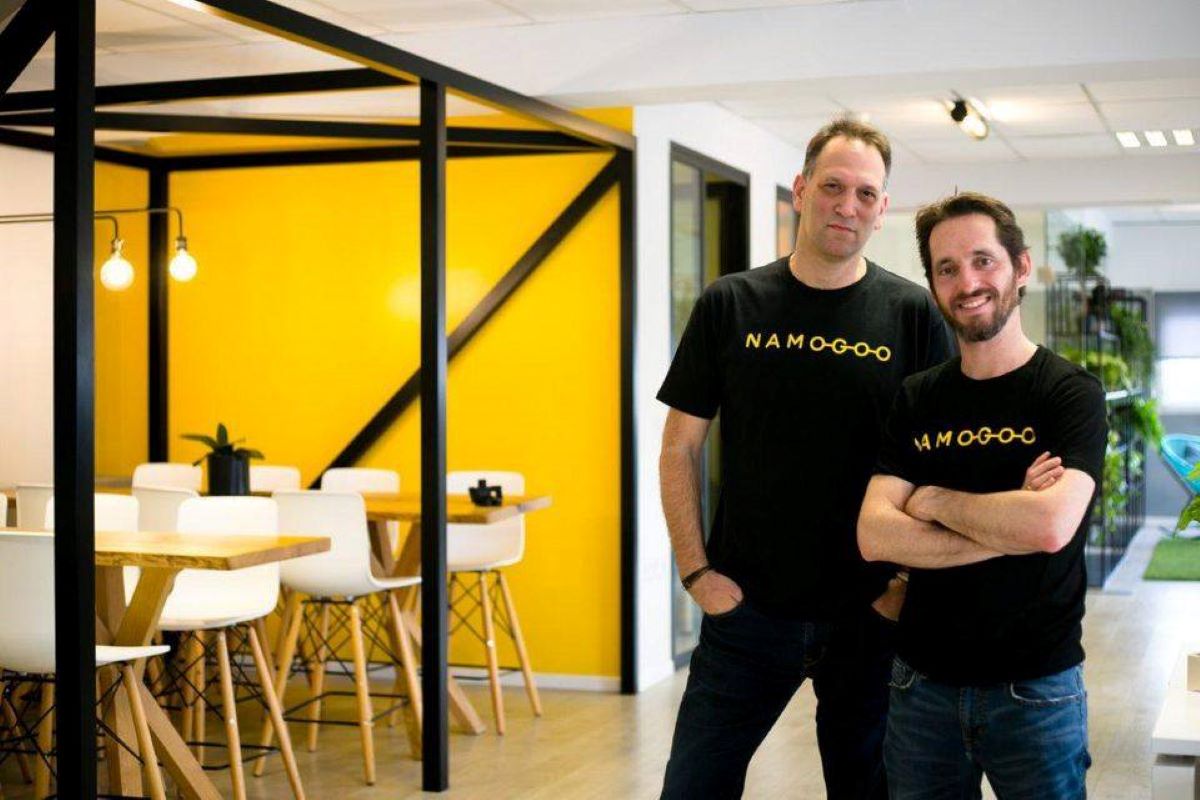NamoGoo and Its Breakthrough Reply to ‘Journey Hijacking’
Founded by Chemi Katz and Ohad Greenshpan in 2014, Namogoo is the world’s first Digital Journey Continuity platform, enabling online brands to drive their customer journeys forward and clear the path to purchase. By preventing unauthorized ad injections that attempt to divert customers to competitors, this platform gives online businesses more control over the customer journey, immediately lifting conversion rates and revenue. In order words, Namogoo’s platform autonomously adapts to each customer visit in real time, keeping the journey flowing right on to its destination. It also helps uncover privacy and compliance risks that can come from the use of third and fourth-party ad vendors.
In 2020, CB Insights named Namogoo, the pioneer of Customer Journey Hijacking Prevention to its inaugural Retail Tech 100 ranking, which highlights the 100 most promising B2B retail tech companies in the world. Brands that have implemented Namogoo’s Customer Hijacking Prevention solution –including leading retailers such as Asics, Carhartt, Dollar Shave Club, Samsonite, and over 250 others – have quickly seen an increase of between 1.5% – 5% in conversion rates and a 5%-7% increase in Revenue Per Visitor.
The Spark to Become Entrepreneurs
As other startup, the idea for Namogoo comes from the co-founder’s daily problems. Chemi Katz’s previous company, Seapai, was an e-commerce aggregator technology company that worked with online brands serving inventory for more than 2.5 million active users. It was during this period that he recognized the significant opportunity he had to revolutionize the e-commerce technology industry.
“Right around the time we were preparing our exit, I was approached by an ad monetization business that wanted to inject ads into our user base. In learning about these ad injections, I discovered how they were able to bypass the server-side security of online businesses and exploit a critical flaw they were not even aware of,” Katz recalled.
Shortly after that, Katz said he was introduced to Ohad Greenshpan — who had founded Fashioholic, a renowned marketing medium for brands and retailers. After performing deep analysis on e-commerce websites, Katz and Greenshpan were surprised about the scale of the issue and immediately “realized the opportunity to truly disrupt the industry with a solution to an unknown problem.”
Then, Katz and Greenshpan created a product and presentation that showed how much revenue e-commerce businesses were losing because of Online Journey Hijacking diverting site visitors to competing offers.
After the product and presentation were ready, the two of them knew they needed to generate industry interest to make progress, so they flew to the UK to meet with several prospective clients. After the prospective customers took an interest in the Customer Hijacking Prevention solution, the two of them knew they were on to something big.

After returning to Israel, they raised $1.1 million in funding — which grew to $5 million within two months. They then started building a development team. Their first client was one of the companies they met on the initial trip to the UK, who happened to be one of the region’s largest retailers.
Significant Problem Namogoo is Solving
When a consumer is browsing on an e-commerce site, they might be exposed to unauthorized, injected pop-ups and banner ads that promote similar products to what they were shopping for. For example, if they are on department store web site looking at shirts, there might be code popping up on that page displaying similar items from a different site. Users who click on those links or ads are whisked away to other sites in a process Namogoo calls “journey hijacking.”
These are not served by the online retailer and are driven by malware that is injected into a consumer’s web browser or device. The unwanted distractions damage a retailer’s brand reputation and divert customers away to competitor sites – leading to losses in revenue for retailers and an interrupted customer experience for shoppers. Unlike ransomware, which is blatant in its demands of payment from users, “digital malware is a silent threat that’s been at work for years,” Katz says.
Katz pointed out that many retailers and online businesses have no idea that Online Journey Hijacking is impacting their sites because such activity is driven by malware that is installed on the consumer side of the experience rather than through the business’ server. And the malware is often injected without the knowledge of the consumer through every day, seemingly harmless, downloads – like an antivirus program or a free PDF viewer update.
Nikki Baird, managing partner of RSR Research, a firm that tracks retail technology, agrees that this sort of malware is particularly hard to pin down. The difference between this and other kinds of malware, explains Baird, is that this threat sits on the network, perhaps on a router at a local coffee shop—it is not something that a consumer downloads to his or her own computer.
“That’s what’s so insidious about this,” Baird says. “A consumer would have no idea they are the victim of this kind of malware because their anti-virus protection is incapable of detecting it. E-commerce sites are on their own to figure out if the consumer’s experience has indeed been hijacked and get rid of the hijacker.”
“Customer journey hijacking is a growing problem that by some estimates affects 15-25% of all user web sessions and therefore costs e-commerce businesses hundreds of millions in lost revenue.” – said Namogoo.
To combat this, Namogoo developed a machine learning-based technology that monitors over 500 million web sessions on retail websites on a weekly basis to block client-side injected malware that manifests as competitive product ads, pop-ups, and other distractions – ensuring retailers that their carefully crafted customer journey is experienced by consumers as intended.
“Namogoo” is a Hebrew word meaning vanished or disappeared, “which is what we do to malware,” Katz notes.

Basically, e-commerce retailers install Namogoo code on their web pages to ensure that they are clean of these rogue links, which can manifest themselves as pop-up ads or perhaps legitimate-looking product recommendations. Depending on the type of code, Namogoo can remove it or simply hide it from the user, thus preventing “hijackings.”
“We are the only technology provider that consistently recovers lost revenue for top online retailers by blocking unauthorized ads injected into consumer browsers on e-commerce sites,” said Katz.
Machine Learning and the Journey to Self-Complete
When Namogoo launched their first product, it was developed with baseline machine learning functionalities, but it did not provide customers with full visibility into data insights.
“We also developed our customer-facing methodology: Pushing real-time data to the customer’s analytics platform from the outset so they can gain full visibility into the scale and impact of Online Journey Hijacking on their bottom-line and reap the value of Namogoo’s solution using their own analytics suite,” Katz added. “And we’ve since expanded our platform with a newly-launched product, Digital Insights, which gives online businesses full visibility into all the third-party services running on their site and their impact on business metrics and site performance.”
Another milestone for the company was when they built a dashboard that provides visibility into how Online Journey Hijacking affects the online customer experience and a brand’s overall reputation. The team then expanded on their machine learning capabilities to learn new patterns and malware code automatically so it would stay up to date with newly emerging malware.
Now, Namogoo’s technology runs on Amazon (AMZN), Microsoft (MSFT), and Google (GOOGL) public cloud infrastructures. The company charges customers via a subscription model, based on how many pages they protect. Namogoo also offers software to detect bot attacks—the sort of which are used to attack web servers. In that space, it competes with companies like Akamai (AKAM).
The On-Going Success
Namogoo says that retailers using its technology see conversion rates increase between 2-5%, which in the first half of 2019 totaled more than $575 million in revenue for Namogoo customers. It is used by more than 150 global brands in over 38 countries, including Tumi, Asics, Argos, Dollar Shave Club, Tailored Brands, Upwork and others. And the response received from helping customers recover revenue they did not even know they were losing “has been remarkable.”
An example of an e-commerce company that implemented Namogoo’s technology is a luxury luggage retailer by the name of Tumi. Tumi was unaware that 15-16% of all traffic to its e-commerce website was experiencing unauthorized pop-ups and banner ads. These ads diverted customers to competing products, along with Tumi products from previous offers at discounted prices and counterfeit products as well. After Tumi implemented Namogoo, the luggage brand found that 20% of previously infected sessions ended up converting and making a purchase on Tumi.com. And the retailer saw an overall conversion rate jump of 2.5%.

Namogoo is also working with sporting goods retailer ASICS to fix the same problem. About 11.7% of the web sessions on ASICS.com contained unauthorized and injected advertisements that distracted potential customers from making a purchase. Once Namogoo’s technology was implemented, ASICS saw a 14.2% increase in conversions for infected users — which translated to an increase in the retailer’s overall conversion rate by 1.6%.
Being asked what the company’s future company goals are, Katz replied: “Our major focus right now is to establish Namogoo as a necessary provider for top e-commerce brands. Looking ahead, we see opportunities to expand our technology into other online business verticals like online travel, fintech, and publishing to ensure their site visitors are offered a distraction-free customer experience.”
Service Expansion: Keys to Drive Customers Forward
Early this year, Namogoo announced the launch of its Intent-Based Promotions solution, empowering retailers of all sizes with automated incentives individualized for every site visit. The first-of-its-kind solution utilizes Machine Learning to predict shoppers’ intent by learning from each visitors’ unique signals and digital behavior in real-time, delivering the optimum promotion needed on each session to ensure that online shoppers complete their journey — even first-time shoppers. By pinpointing the most effective promotion for each visitor session, brands can expect at least a 25% reduction in promotion costs while achieving a 15% increase in revenue.
“With Namogoo’s unique proprietary technology retailers can now shift their promotion budget away from visitors who would have purchased anyway or have no shopping intent, and towards visitors who will convert when presented with the right promotion at the ideal moment in the customer journey, protecting both their margins and brand perception,” said Ohad Greenshpan, Namogoo co-founder and CTO. “Our Digital Continuity Platform is elastic and can support businesses of any size, from Fortune 500 companies to mid-market.”
“Retailers know that every phase of every site visit is an opportunity that can either be won or lost, and in this incredibly competitive retail environment, losing customers is not an option,” said Katz. “The addition of Intent-Based Promotions to our Digital Journey Continuity platform ensures that every site visit stands the best chance of converting. In short, we are both clearing the path, and driving customers forward, and when customer journeys flow, everyone reaches their goals.”
The addition of Intent-Based Promotions will enable eCommerce brands — from retail giants to SMEs — to turbocharge their promotion strategy, allowing each customer journey to reach its full potential. This also increase Namogoo’s coverage level on the market, which leads to the company’s expansion.
The Bottom Lines
By pioneering in solving a problem that affects not only buyers’ experience but also retailers’ revenue, Namogoo is contributing to creating better online environment for ecommerce & retail. Business in this field can learn from model Namogoo is operating to optimize their customers’ journey, thus increase profit.









